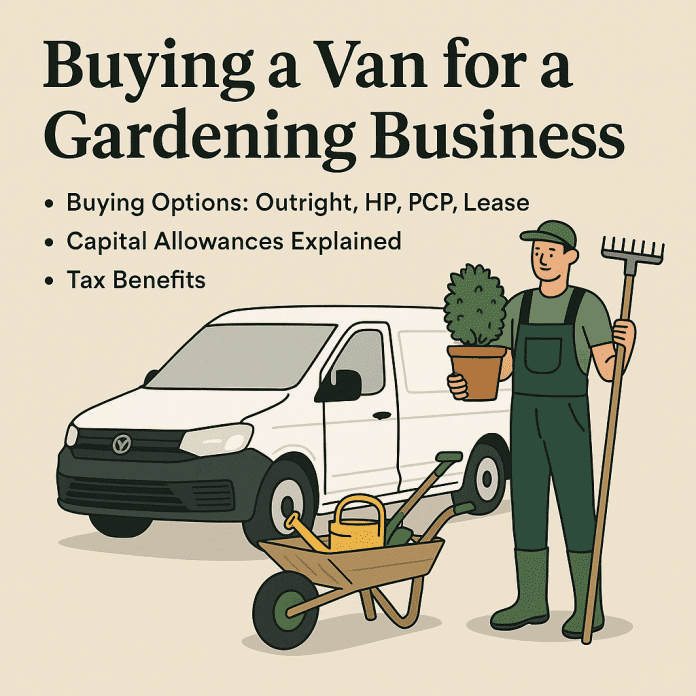Starting or scaling up a gardening business in the UK often means getting your hands on a dependable van. Whether it’s for hauling tools, plants, compost, or waste, a van is the beating heart of many green-fingered enterprises. But what’s the most affordable and practical way to get one — especially if you’re working with a limited budget?
In this guide, we’ll break down the most cost-effective ways to get a van, from buying outright to flexible finance options, tailored for sole traders and small business owners in the gardening trade.
1. Buying Outright – Simple and Debt-Free
If you have cash available — around £3,000 to £4,000 — you can buy a used van outright with no monthly payments or finance agreements.
Pros:
- You own the van immediately.
- No interest or finance charges.
- Complete freedom with mileage, insurance, and usage.
Cons:
- You’ll likely be limited to older vans with higher mileage.
- Expect to spend extra on repairs, MOTs, or tyres.
Popular Vans in This Range:
- Ford Transit Connect (2005–2011)
- Vauxhall Combo (2007–2012)
- Citroën Berlingo / Peugeot Partner
- Fiat Doblo Cargo
- Renault Kangoo
Check platforms like Auto Trader, Facebook Marketplace, and Gumtree, and consider a mechanic’s inspection if buying privately.
2. Hire Purchase (HP) – Spread the Cost, Own the Van
Hire Purchase is a popular finance method for tradespeople. You pay a deposit (e.g. £3,000), then spread the remaining cost over 1–5 years with fixed monthly payments. Once all payments are made, you own the van.
Pros:
- You end up owning the van.
- No mileage limits.
- Fixed interest and predictable payments.
Cons:
- Monthly payments are higher than lease or PCP.
- You don’t own the van until the final payment is made.
- Missed payments can lead to repossession.
Example:
- Van price: £6,000
- Deposit: £3,000
- Remaining: £3,000
- Term: 24 months
- Monthly payment: ~£140 (9.9% APR typical)
Use reputable dealers or finance providers such as MotoNovo, Vanarama, or local independent dealerships.
3. PCP (Personal Contract Purchase) – Flexibility, But Read the Fine Print
PCP offers low monthly payments and flexibility at the end of the term. After 2–4 years, you can return the van, trade it in, or pay a balloon payment to keep it.
Pros:
- Lower monthly payments than HP.
- Access to newer vans.
- Ideal if you plan to upgrade every few years.
Cons:
- Mileage caps (typically 10,000–12,000 miles/year).
- You don’t own the van unless you pay the final lump sum.
- Excess wear or mileage can incur charges.
Best For:
- Urban gardeners who want a clean, modern van with minimal hassle — but who don’t plan to heavily modify or use it off-road.
4. Van Leasing – Drive New, Don’t Own
Leasing a van (Contract Hire) means you’re renting it long-term — often 2 to 4 years — with fixed monthly payments. Maintenance may be included, and there’s no big payment at the end.
Pros:
- Low monthly payments.
- Reliable, modern van with a warranty.
- Great for budgeting with fixed running costs.
Cons:
- You never own the van.
- Strict mileage and wear-and-tear conditions.
- Custom branding or modifications may not be allowed.
Typical Costs:
- Initial rental (3–6 months up front): £2,000–£3,000
- Monthly rental: £150–£200 for small vans
- Examples: Ford Transit Courier, Peugeot Partner, Citroën Berlingo
Ideal for new businesses that value reliability and image more than ownership.
5. Buying at Auction – High Risk, Low Cost
Motor auctions can offer real bargains, particularly for ex-fleet or ex-council vans with service histories.
Pros:
- Lowest prices.
- Access to fleet-maintained vans.
Cons:
- No test drives.
- “Sold as seen” — no warranty or comeback.
- You’ll need to register, pay a buyer’s fee, and act fast.
Check out BCA (British Car Auctions) and Manheim Auctions — both have online platforms and local branches.
Conclusion: What’s Right for You?
| Method | Best For | Ownership | Mileage Limits | Cost Control |
|---|---|---|---|---|
| Buy Outright | Budget buyers, experienced van owners | Yes | No | High |
| Hire Purchase | Long-term users, tradespeople who want to own | Yes (at end) | No | Medium |
| PCP | Short-term use, modern image | Optional | Yes | Medium |
| Lease | Image-conscious, low-maintenance, short-term plans | No | Yes | High |
| Auction | Risk-takers with mechanical know-how | Yes | No | Low |
Each van acquisition method has different tax implications, especially if you’re self-employed or running a small limited company. Here’s a breakdown of the tax benefits (and drawbacks) of each van buying option in the UK, as they relate to HMRC rules:
1. Buying Outright
Tax Benefits:
- You can claim capital allowances on the van, including:
- Annual Investment Allowance (AIA) – often lets you claim 100% of the cost in Year 1 (up to £1 million annually).
- All running costs (fuel, insurance, maintenance, MOT, etc.) are deductible as business expenses.
- If you’re VAT registered and buy from a VAT-registered dealer, you may reclaim the VAT (if the van is for 100% business use).
Best for:
- Sole traders or limited companies with the cash upfront and looking to reduce taxable profits.
2. Hire Purchase (HP)
Tax Benefits:
- Treated like buying outright for tax purposes.
- You can still claim capital allowances on the full value of the van — even though you’re paying monthly.
- Interest on the finance is a deductible business expense.
- Full running costs are deductible too.
- VAT can often be reclaimed on the purchase if the dealer charges VAT and the van is for business use.
Best for:
- Businesses that want ownership with manageable cash flow and clear tax write-offs.
3. PCP (Personal Contract Purchase)
Tax Benefits:
- If you intend to keep the van, HMRC may treat it like a purchase — allowing capital allowances.
- If you don’t keep the van, it may be treated more like a lease — and only the monthly payments are deductible, not the full value.
- Balloon payment is not deductible unless you buy the van.
- Interest on payments may be deductible.
- You can reclaim VAT on the business-use portion of the payments (if applicable).
Best for:
- Less clear-cut. Only worth it tax-wise if you buy the van at the end and use it mostly for business.
4. Leasing (Contract Hire)
Tax Benefits:
- Monthly lease payments are fully deductible as a business expense (assuming 100% business use).
- If VAT registered, you can reclaim 50% of the VAT on the lease payments (or 100% if the van is used exclusively for business).
- You can’t claim capital allowances because you don’t own the van.
Best for:
- Businesses looking for predictable deductions and no ownership complications.
5. Buying at Auction
Tax Benefits:
- Same as buying outright: you can claim capital allowances.
- VAT reclaiming depends on whether VAT is included in the sale and how it’s invoiced (not always straightforward at auction).
Bonus: Self-Employed vs. Limited Company
| Structure | What’s Deductible |
|---|---|
| Self-Employed | Capital allowances claimed through your Self Assessment (use simplified expenses if claiming flat-rate vehicle use). |
| Limited Company | Claim capital allowances and vehicle expenses through corporation tax. Van can be a company asset — but if there’s personal use, a Benefit in Kind (BIK) charge may apply. |
Note: HMRC treats vans differently to cars. Vans used mainly for work (tools, deliveries, commuting) have more favourable tax treatment and lower or no BIK — especially important for limited companies.
Summary Table: Tax Benefits by Method
| Method | Capital Allowances | Deductible Costs | VAT Reclaimable | Ownership |
|---|---|---|---|---|
| Buy Outright | Yes (AIA) | All running costs | Yes (if VATable) | Yes |
| Hire Purchase | Yes (AIA) | Running + interest | Yes | Yes (at end) |
| PCP | Sometimes (if bought) | Partial | Partial | Optional |
| Lease | No (monthly cost only) | Lease payments | 50%–100% | No |
| Auction | Yes (AIA) | Running costs | Sometimes | Yes |
What Are Capital Allowances?
Capital allowances let you deduct the cost of big business purchases — like vans, tools, or machinery — from your taxable profit. Instead of deducting the full cost as a regular expense, HMRC lets you claim it through capital allowances over one or more years.
If you’re self-employed, this reduces your Self Assessment tax bill.
If you run a limited company, it reduces your corporation tax.
How Capital Allowances Work for Vans
Example:
Let’s say you buy a van for £5,000 and use it 100% for business.
- If you qualify for the Annual Investment Allowance (AIA), you can deduct the full £5,000 from your profit that year.
- If you’re a basic rate taxpayer (20%), that could save you £1,000 in tax.
Main Types of Capital Allowance
1. Annual Investment Allowance (AIA) – Most Common
- Lets you deduct 100% of the van’s cost in the year you buy it.
- Applies to most business assets, including vans (but not cars).
- AIA limit is £1 million per year — more than enough for most small businesses.
Perfect if you want to reduce your tax bill quickly.
2. Writing Down Allowance (WDA) – If You Don’t Claim AIA
- If you don’t or can’t claim AIA, you can claim WDA.
- You deduct a percentage of the van’s value each year.
- The rate for most vans is 18% per year (main pool).
- This spreads the tax benefit over several years.
Example:
Van costs £5,000.
Year 1 WDA = £900 (18%)
Year 2 = 18% of the remaining £4,100, and so on.
3. First Year Allowance (FYA) – For Green Vehicles
- Not usually relevant to vans unless you buy an electric van.
- FYA lets you claim 100% of the cost in year one, just like AIA.
- Used for environmentally friendly equipment.
VAT and Capital Allowances
If you’re VAT registered and reclaim the VAT on the van:
- You must subtract the VAT from the purchase price before claiming AIA or WDA.
- Example: Van cost = £6,000 inc. VAT.
VAT = £1,000.
Capital allowance is claimed on £5,000 (net).
If you’re not VAT registered, claim capital allowances on the full price you paid.
Personal Use – Watch Out!
If you use the van partly for personal use, you can only claim the business-use portion of capital allowances.
Example:
- 80% business use = only 80% of the van’s value is claimable.
- Keep mileage logs to back this up if HMRC ever asks.
How to Claim Capital Allowances
- Self-employed: Claim via the “capital allowances” section of your Self Assessment return.
- Limited company: Your accountant includes it in your corporation tax return (CT600).
Summary Table
| Capital Allowance | How Much? | When to Use | Applies To |
|---|---|---|---|
| AIA | 100% in Year 1 | Best for most van purchases | All vans (not cars) |
| WDA | 18% annually | If you don’t/can’t use AIA | All vans |
| FYA | 100% in Year 1 | For electric/eco vans | Low-emission vehicles |
| VAT Rules | Deduct VAT first if reclaiming | If VAT registered | Business-only use |
A used van can kickstart your gardening business for under £3,000, but if you’re ready to scale or want something more modern and reliable, spreading the cost with HP or leasing may be the way to go.
Tip: Whatever route you choose, always budget for:
- Insurance
- Tools and shelving
- Signwriting or magnetic signs
- Road tax and MOT




